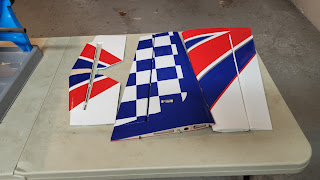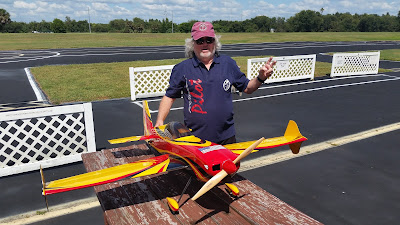Search This Blog
Wednesday, December 15, 2021
Extreme Flight 48" MXS EXP V2__A Look At The Kit
Wednesday, October 20, 2021
October Video Wrap Up
Slick EXP__Before The Storm.mp4 from Doc Austin on Vimeo.
60" Edge V2
Here is another sadly underutilized plane from my fleet. Last year we got so many new releases I barely had to build it and get a video or two before the 60" MXS V2 came out. With the holidays coming and all, there was just no time to do it proper justice, but we're catching up on that now. Mostly I feel guilty flying this plane because it's so smooth, stable, honest and easy to fly that it really is the unfair advantage.
Edge V2__Top Of The Food Chain.mp4 from Doc Austin on Vimeo.
60" MXS EXP V2
A little cheating here because we shot this in September, but hopefully a good representation of how much I like this plane. All the latest stuff is nicer than ever, but the MXS is just even better. Everything was so well done the plane fell together seamlessly and was an absolute joy to set up.
I have a special connection the the MXS and have always loved this plane, but the V1 was starting to look a little dated. Along with the V2 construction and the beautiful new color scheme, this is currently the nicest plane I have ever owned. Some of this assessment could be sentimental too, but clearly this is one super damm nice airplane.
Wednesday, April 7, 2021
3DHS Velox Revolution__Long Term Product Evaluation
3DHS Velox__Doc Austin's Day Off from Doc Austin on Vimeo.
I'm going to keep writing, but a little later in this article we will have today's video where I fly it around like a normal person and show you the stupid crazy stability and ease of flight. The Velox' laid back nature when flying it easy is simply astonishing.
It is worth nothing that today everyone dropped what they were doing and lined up along the fence whenever the Velox went up. We were doing something a little different and I think they were all shocked that such a high performance aircraft would fly in such a gentle manner. Either way, everything else aside, the Velox draws a big crowd just because it's so cool and badass looking. I've taken it to an event and I got lots of positive comments about it. I've also let a few people fly it and they now have their own. The flying doesn't lie.
Set Up3D Hoby Shop Velox_Too Much Fun.mp4 from Doc Austin on Vimeo.
There's actually a lot to be said for backing off on the intensity to get a good, smooth flight. The plane is so stable I can still fly hard and not have much trouble, but backing off a little gives you a more composed presentation. If you're trying to showcase a plane's stability and precision this is a pretty good technique. When you start pushing really hard it's easy to get sloppy, either from adrenalin or just skirting your own personal limit. That's ok on an agility video because crazed flying is always fun to watch too.
Today was a good lesson on backing off and giving a more balanced flight. I'm not going to abandon the wild stuff, but I will be incorporating more sedate flying that the new guys won't be afraid to try, and that's who we want to help most anyway.
Here we go a little off script, and I fly the plane really hard, though with a bit more margin, and taking the time to set everything up better, and manage the flow. I just slowed it down a little to take my time and get it right. I blow a couple of exits, but the wind was really howling, and maybe I relaxed too much and got sloppy. In general I think it is a different style and looks better in it's own way. It's a different look from all out gonzo, but if it makes the presentation look better and it's more fun, this is more the way I'm going to fly this plane.
3D Hoby Shop Velox_Too Much Fun 002.mp4 from Doc Austin on Vimeo.
The new Zonker3DHS Velox__3DHS Velox__Doc Austin's Day Off 4 from Doc Austin on Vimeo.
Let's be clear here about one thing. This is a 100% blood and guts old time rock and roll 3DHS fly low plane all the way. It may be a Velox, but it's character and soul has the deep running roots of the original Extra SHP, and especially the SR. Most of us grew up flying those planes, and in honesty, they made me into a pilot.
From here how do you summarize a plane that defies the conventional wisdom that you have to sacrifice something to get something? OK, maybe the Velox gives up a percent or two to the Extra in grace, and maybe the Edge is a percent easier and more stable, but it's so close any intermediate pilot can make up that difference after a flight or two. The Velox does everything sparklingly well, and it's performance bias, while a little different, rivals the Extra for being the best rounded plane in the lineup.
Finally a note of thanks to Ben Fisher for his patience and guidance from the early years. I didn't know jack about set up, but he brought me along and many, many of the things I instinctually applied on this project comes directly from what I learned from him. He designs a pretty mean plane too.
That, and the Boss rocks.
Finally, and this time for real, for cell users YouTube seems to work better for cell phones or slower connections, so we will give it a try. For this video, you will want to crank the sound.
.

Friday, April 2, 2021
Setting up an Aura for sport 3D
Electronic Stability Systems (ESS) are becoming less of a novelty and more of just a piece equipment that allows you to get the most out of the airplane. I run Auras in everything I own, simply because the planes fly better and I crash less. Every Aura I own has paid for itself over and over, so to me this makes them essential. You don't actually need one, but if you fly in a lot of wind or are not a top level professional pilot, you'll get better results with one.
Generally an ESS just stabilizes the plane. A good system can level the playing field between super stable planes and ones that sacrifice a little stability to get agility. For example, a 48" MXS is a great little plane, but it's so agile you have better know what you are doing if you're going to hammer it hard. This kind of goes away with a stability system because that plane becomes an utter pussycat without giving up any agility. On that plane the transformation was mind blowing.
One odd thing I discovered is that as you go smaller, the ESS makes a bigger difference. On 60" planes the ESS makes the plane smoother and, of course, more stable, but on a 52" the difference is very, very noticeable. On a 48" it's pure utter magic on a biblical scale. My first ESS was on a 52" and I fell in love with it immediately, but on a 48" it was like flipping a light switch. Conversely, on a 74" or 92, the effects are more subtle.
So, the smaller you go, the more improvement you get, to the point size becomes largely irrelevant, at least from a stability standpoint. The beauty here is that on a small plane you get big plane stability without giving up any of the smaller plane's agility.
Disclaimers
First we have to get the disclaimers out of the way. People often want my config file, but that is problematic unless you fly Futaba. Also, I can't put myself in a position of liability, so I am loathe to share them. My formula is so simple you won't have much trouble anyway.
However, my formula for gains and stick priorities work on every system I have tried, so that's what we will focus on.
I fly 48" to 60" planes exclusively, so if you are flying something bigger you might be able to up the gains a little and get away with it. I've tried this formula on friends 74" and 104" plane with good results, but I won't have a definitive formula for bigger planes until I have my own to tinker with, or just a lot of time experimenting with someone else's expensive toy. You don't keep your friends if you crash a lot of their planes, and volunteers are kind of rare, so this could be awhile!
No report is complete without a smokin' video. Here we combined the Velox' smooth precision with nice weather and a great anthem. Make sure you crank it up!
MY CONFIG
When you go into the Aura config tool, look for file/new Aura Config file Wizard. From there, choose "custom airframe" and the "generic 3D" template. For most people that's a great place to start and you might just be happy with it the way it is.
I go a slightly different route in separating my rates, expo and mixes from the Aura and run those in the TX. That way those are independent from the Aura and work like they normally do. Then I run only an off/high/high Aura setting. Off is off, and the two highs are identical. I trim the plane, turn the gyro on and never think about the Aura ever again. Essentially, we fly the plane just like we always have with a choice of rates on your dual/triple rate switch, and that's it. The gyro gains and stick priorities are the same all the time, and I'm too busy flying the plane to worry about it. It's just one less thing for the pilot to get wrong, and this is especially important for the new guys who are struggling with everything else.
Simplicity counts.
Get the Aura wired up and everything working. Then you can change servo direction and sub trims in the Aura. If you can get that far, the rest is cake.
GAINS
























































